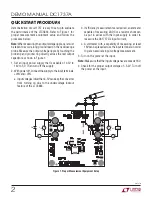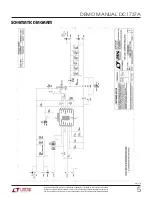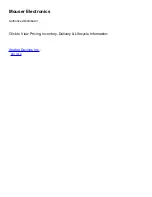
3
dc1737af
DEMO MANUAL DC1737A
QUICK START PROCEDURE
I
OUT
(A)
EFFICIENCY (%)
90
85
80
65
75
70
1
0.01
0.1
V
IN
= 5V
V
IN
= 12V
I
OUT
(A)
EFFICIENCY (%)
90
85
80
65
75
70
1
0.01
0.1
V
IN
= 5V
V
IN
= 12V
5. Once the proper output voltage is established, connect
a variable load capable of sinking 1.7A at 5.2V to the
output terVOUT and –VOUT. Set the current
for 0A.
a. If efficiency measurements are desired, an ammeter
or a resistor shunt that is capable of handling 1.7A
DC can be put in series with the output load in order
to measure the DC1737A’s output current.
b. A voltmeter with a capability of measuring at least 12V
can be placed across the output terminals in order
to get an accurate output voltage measurement.
6. Turn on the power at the input.
Note: If there is no output, temporarily disconnect the load
to make sure that the load is not set too high.
7. Once the proper output voltage is again established,
adjust the load and/or input within the operating range
and observe the output voltage regulation, ripple volt-
age, efficiency and other desired parameters.
8. Remove the VOUT jumper to observe operation at
–12V
OUT
up to 1A.
Figure 2. –12V
OUT
Efficiency with Burst Mode Operation
at Light Loads
Figure 4. Output Ripple at 12V
IN
, –12V
OUT
and 1A Out
(50mV, 2µs/Div, 20MHz)
Figure 5. Transient Response Waveform at 12V
IN
, –12V
OUT
and 0.5A to 1A to 0.5A Out (0.5A, 100mV, 10µs/Div)
Figure 3. –5.2V
OUT
Efficiency with Burst Mode Operation
at Light Loads







